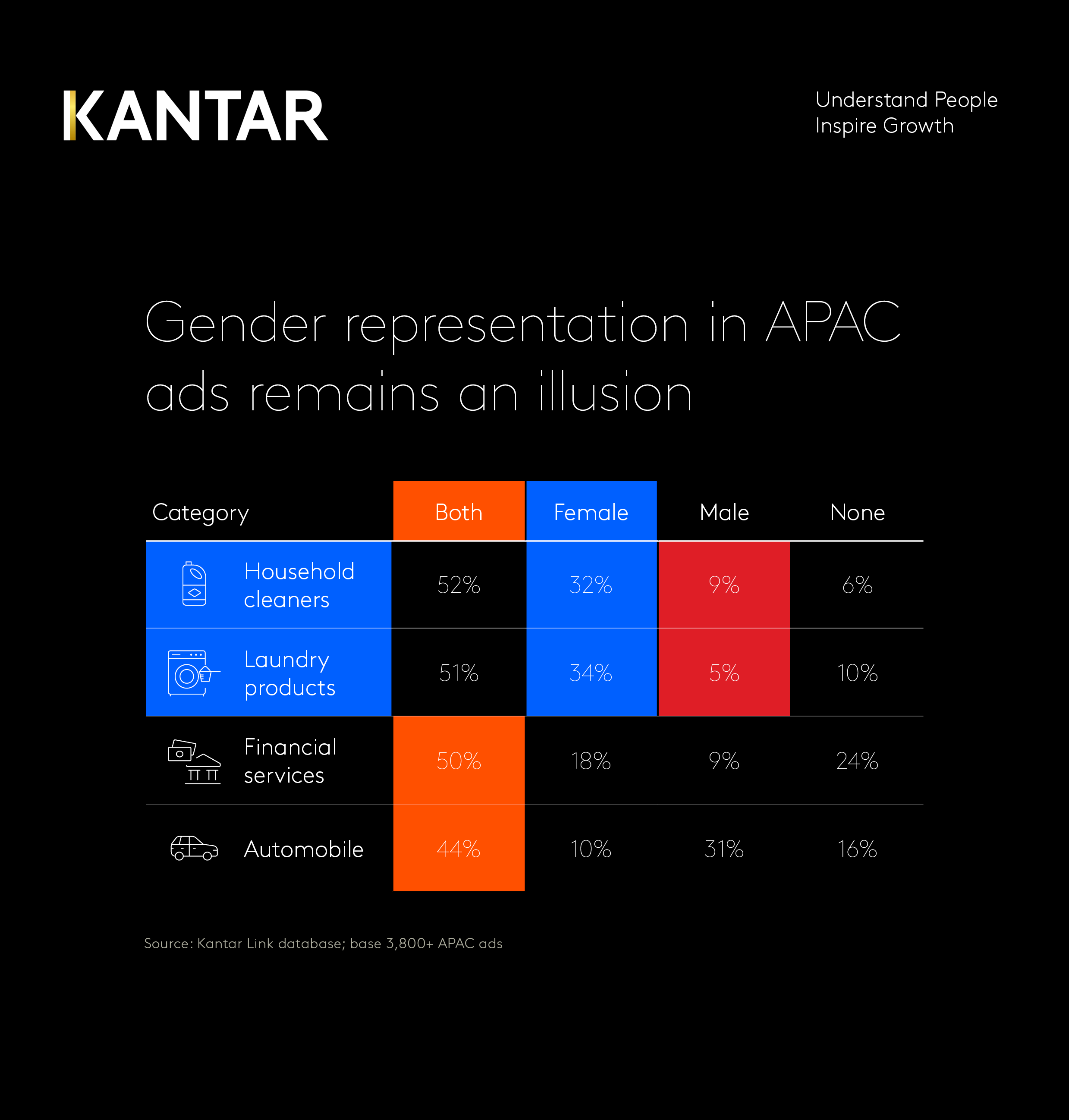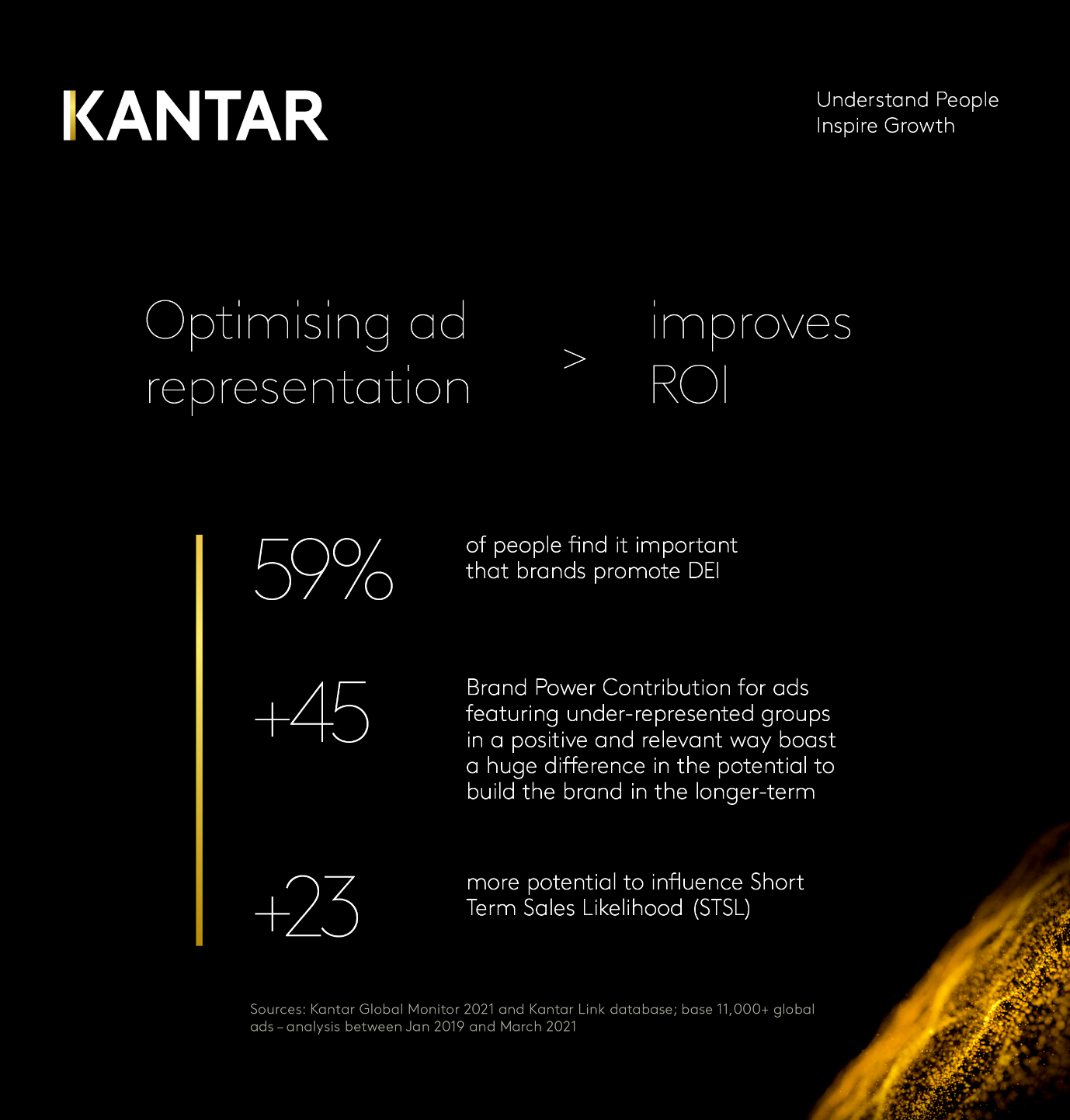Purpose Incorporated: A primer for brands in APAC
This article is part of a special series on how brands in APAC can go beyond profit to do good and do better for themselves and others. Read more.
Non-WARC subscribers can read this series in its entirety by accessing the articles via the landing page.
Why it matters
Not only is optimising ad representation the right thing to do but it also improves ad performance, with ads that feature under-represented groups in a positive and relevant way showing a huge difference in the potential to build the brand in the longer term.
Takeaways
- Equal gender representation remains an illusion with less than half of APAC ads depicting both men and women.
- In advertising, consumers seek relevant representation in the casting and character development reflected in the narrative.
- APAC’s diversity can be daunting, so it is important to understand what is culturally appropriate in each sub-region.
As advertising actively shapes cultural discourse, the pandemic has thrown socio-economic inequalities into sharp focus. The proliferation of social media platforms has given consumers a bolder and louder voice to talk diversity, equality and inclusion (DEI). The demands on representation of progressive role models and hitherto under-represented segments are gaining momentum. To grow your brand across Asia Pacific, it’s imperative to establish consumer trust by demonstrating how your brand engages in DEI authentically.
While some progress in advertising representation has been made globally, analysis of Kantar’s validated Link ad testing database across Asia Pacific reveals a much lower representation of ethnicity (8% versus 25% globally) and skin tones (10% versus 19% globally). And less than 1% of Asian ads overtly show LGBTQIA++ individuals, while only 1% feature people with disabilities. We have come some distance but there is still a long way to full representation.
Equal gender representation remains an illusion
Less than half of Asia Pacific ads depict both men and women with this skew higher in some categories. Despite campaigns like Ariel’s “Share the Load”, laundry seemingly continues to be the woman’s load to bear with just 5% of laundry ads feature men. Both genders are only represented in 50% of financial services and less than half of automotive ads across the region.

Optimising ad representation improves ad performance
So to what end should you drive representation if you have a specific target audience? The answer lies in the success stories of brands that do this well.
Kantar’s Global Monitor 2021 finds three in five people (59%) say it is important that companies actively promote diversity and inclusion in their own businesses and society – even more so among millennials and Gen Z.

Ads featuring under-represented groups in a positive and relevant way boast a huge difference in the potential to build the brand in the longer term (+45 on power contribution) and more potential to influence short-term sales likelihood (+23 on STSL) according to our global Link ad testing analysis between January 2019 and March 2021. Positive representation also actively helps build brand trust – an essential to win in the current competitive marketplace. Tokenism, however, does not work the same wonder.
This works beyond big advertisers and TV spots too. For example, YouTube content featuring female-led and gender balanced content attracts 30% more views than male-dominated videos, according to analysis of 2.7 million videos over four years by Google and the Geena Davis Institute on gender in media.
Three ways to connect with consumers meaningfully
By following these steps, your brand is on the right journey towards establishing vital consumer trust and getting representation in advertising right.
1. Be relevant and inclusive
A product or packaging innovation created for marginalised and under-represented consumers takes your brand a long way. The recent McDonald's EatQual inclusivity initiative in India uses a specially designed case to hold the burger together to help people with limited hand mobility enjoy their food without any difficulty.
In advertising, consumers seek relevant representation in the casting, character development, the fulfilment of tensions or aspirations and point of view reflected in the narrative. To achieve this, it’s imperative to have a strong cultural consumer understanding that lends itself to powerful storytelling and is uniquely aligned to the category and brand. This need not be fuelled by any greater purpose beyond telling consumers everyone is welcome, as seen in McCain’s “We are family” in Australia.
If you do tackle a specific under-represented cultural segment, consider integrating a single relevant tension around identity into the conversation. Pantene’s #PrideHair campaign in Japan featuring trans models talks to the LGBTQ+ community’s struggles around job interviews and identities being put to the test.
2. Tell meaningfully inclusive brand stories
Integrating your brand and elevating its role in the life of the under-represented is a natural way to be meaningfully inclusive. Nestlé’s Bear brand ad in Indonesia delivers a simple extension of the brand message through a public transport driver going through the effort to learn sign language to be able to connect with his passenger.
Another powerful example is in the gaming category, perhaps one of the more unlikely places to seek inclusive advertising. That is what makes this HP Omen ad noticeably different as it takes on the status culture in South Korea.
3. Get intersectionality and inclusive insights right
We are all aware that people do not fit into one box. Kimberlé Crenshaw’s concept of intersectionality is a beacon for advertisers bringing alive the different dimensions of identity and identifying the nature of discrimination that they experience. Colgate in Thailand has addressed this by bringing the issue into the narrative and the role of the brand – be it ageing, LGBTQIA++ or people with disabilities.
However, embracing our region’s great diversity can be daunting, so it is important to understand what is culturally appropriate in each sub-region.
- South Asia: Representing ethnicity (beyond the mainstream), skin tones, the underprivileged and disability is the first step. Your brands can create elevating conversation, strong messaging of support, assertion and pride. There is scope to push the envelope and even become a rallying force for action.
- Southeast Asia: Start by acknowledging differences and represent skin tones and ethnicities within Thailand, Indonesia and Malaysia. Avoid being confrontational or rebellious and ensure that your advertising does not take on fundamental cultural values.
- Oceania ANZ: Inspiring narratives around inclusion, diversity and equality are welcome. But it must feel natural, simple and differentiated from the many voices in the market. On-ground initiatives indicate positive community mobilisation alluding to not just ads but acts by brands.
Getting Diversity, Equality and Inclusion (DEI) right in Asia Pacific is up to you. Your brand must engage with consumers at a deeper level to understand inequalities. Start at the fringes and work your way to your brand’s core consumer but never lose sight of your brand’s unique story and how it can solve challenges people face.
8 powerful steps for your creative process to build DEI
Pre-production
- Ensure your creative team is diverse and allows for varied perspectives into the process.
- Keep your finger on the pulse of culture and consumer trends – address relevant societal topics in a way that is authentic to your brand.
- Identify what inclusion means to your target market or region and what resonates.
- Actively seek out opportunities for inclusive ad casting.
Post-production
- Confirm that you have achieved the inclusion as intended.
- Check that you have achieved progressive presence.
- Double check for inadvertent stereotypes.
- Measure ad performance against objectives and optimise for success.
Consciously applying these steps to the campaign process will help to make sure you are on the right path to create truly inclusive advertising that matters to and resonates with your audience.
Creativity is never to be undermined in the process of developing truly meaningful, differentiated and compelling brand stories that drive growth and make the world a better place.

